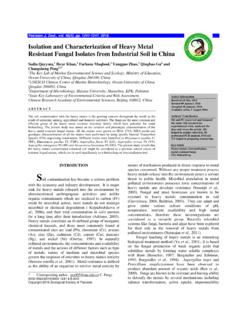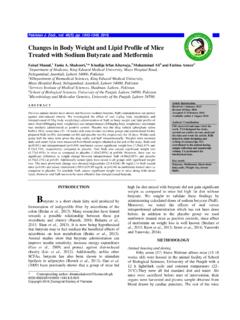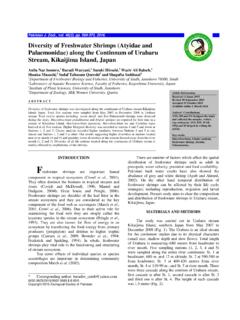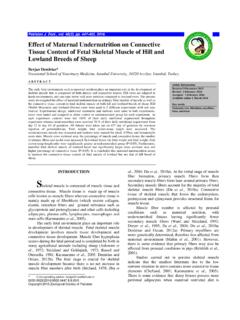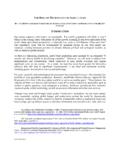Transcription of The Correlation Between Polymorphisms of the …
1 Pakistan J. Zool., vol. 48(5), pp. 1283-1290, 2016. The Correlation Between Polymorphisms of the MSTN Gene and Slaughter Traits in Sansui Ducks Zhong-Hai Zhao,1,2 Hui Li,1,2,* Heng-Jie Yi1,2 and Bang-Xing Peng1,2 1 College of Animal Science, Guizhou University, South Campus, Huaxi District, Guiyang, Guizhou 550025, People s Republic of China. 2 Key Laboratory of Animal Genetics, Breeding and Reproduction in the Plateau Mountainous Region, Ministry of Education, Guizhou University, South Campus, Huaxi District, Guiyang, Guizhou 550025, People s Republic of China. A B S T R A C T Direct sequencing of PCR amplicons was used to identify single nucleotide Polymorphisms (SNPs) in the Sansui duck (Sansui Sheldrake duck) myostatin (MSTN) gene exons.
2 In addition, the genetic effects of the MSTN gene on slaughter traits were analyzed. The results showed that in the studied sample groups, six SNPs ( >A, >G and >A of exon1; >A, >C and >A of exon3) were found in the MSTN gene. The G/A mutation in the >A SNP resulted in the change of codon from GGC to AGC, and the coding amino acid from Gly to Ser. Additionally, the association tests Between SNPs and slaughter traits showed that >G affected the breast muscle percentage and lean meat percentage; and > >C affected the semi-eviscerated weight and eviscerated weight. We conclude that the MSTN gene could be regarded as a useful candidate gene for carcass traits in Sansui ducks. INTRODUCTION The myostatin (MSTN) gene encodes a growth factor, sometimes referred to as growth differentiation factor 8 (GDF-8).
3 The MSTN gene was discovered by McPherron and Lee (1997a) in a study of the transforming growth factor- (TGF- ) superfamily. They showed that MSTN is a negative regulator of muscle growth. The MSTN gene is associated with the growth and differentiation of animal skeletal muscle, and the loss of gene function would cause skeletal muscle growth abnormalities (Lee and McPherron, 1999; McPherron and Lee, 1997b; Kambadur et al., 1997). The MSTN gene is highly conserved in different species, the human, pig, cow and chicken genes all contain three exons and two introns. Studies in cattle (Di-Stasio and Rolando, 2005), pig (Jiang et al., 2002) and chicken (Gu et al., 2003) showed that the MSTN gene is an important candidate gene for carcass and meat traits.
4 Research into MSTN gene Polymorphisms in duck is comparatively rare. In GenBank, there are only two MSTN transcript variants of Peking duck, which were obtained as using a whole genome shotgun strategy. For other breeds, only partial coding sequences have been deposited. The Correlation Between Polymorphisms in the MSTN gene and slaughter traits has not been reported. _____ * Corresponding author: 0030-9923/2016/0005-1283 $ Copyright 2016 Zoological Society of Pakistan Sansui ducks are a local breed of Guizhou province. Currently, studies of Sansui ducks have been limited to the impact of breed characteristics, body measurements, slaughter traits, and muscle and egg nutritional components.
5 Studies at the molecular level are also limited. Therefore, in this study we used 17-week-old Sansui ducks to study the association of single nucleotide Polymorphisms (SNPs) in MSTN exon and slaughter traits. The aims of this study were to find a marker related to slaughter traits of Sansui ducks, to provide basic data for marker-assisted selection of ducks, and to provide a reference for further study of the MSTN gene in other breeds. MATERIALS AND METHODS Test materials The population used for the association analysis comprised 60 pure bred Sansui ducks (50% male and 50% female), but individuals within gathering colonies repelled one another. The treatment conditions were the same for all animals, and the ducks were slaughtered at 17 weeks old.
6 The measured carcass traits were: weight before slaughter, carcass weight, half carcass weight, eviscerated weight, breast muscle weight and leg muscle weight, dressing percentage, semi-eviscerated percentage, eviscerated weight percentage, leg muscle percentage, breast muscle percentage, lean meat percentage. The experimental procedures were performed according to the protocols approved by the Biological Studies Animal Care and Use Committee of Guizhou, People s Republic of China. Article Information Received 13 February 2015 Revised 18 January 20016 Accepted 29 January 2016 Available online 1 August 2016 Authors Contribution ZH Z collected samples, performed the experiments, analyzed the data and wrote the article.
7 HL is the project leader and corresponding author. BXP and HJY collected samples, performed the experiment and analyzed the data. Key words Sansui duck, MSTN, SNPs, slaughter traits, myostatin. ZHAO ET AL. 1284 Table .- PCR primer information. Primer name Primer sequences (5 3 ) Product size Annealing temperature ( C) Amplified region P1 F: GAACTGAAAGAAAAGGGGAAAG R: GACGAAAGCAGCAGGGTT 472bp C P2 F: TTTGTTCCCTGTTCAGTAAT R: CAAGTTAAATGCTTTCCAAT 480bp C P3 F:GAGACTTGTAGGAGGATAAAG R:ACAGTTTCAAAGATGGGTG 638bp C Table П.- PCR reaction conditions. Primer name Pre denaturation at 95 C Denaturation at 94 C Annealing ( C /s) Extend at 72 C Cycle number Again extend at 72 C P1 4min 40s C /40s 45s 35 5min P2 35s C /40s 40s 30 P3 45s C /50s 50s 30 Genomic DNA extraction A genomic DNA extraction kit (Tiangen Biotech, Beijing, China) was used to extract DNA from blood samples, and the products were detected using agarose gel electrophoresis.
8 We measured their optical density (OD) using a spectrophotometer, and determined that their concentrations were 100 200 g/ L. Primer design The primers used in the PCR amplification are listed in Table I. The primers for the three exons of MSTN were designed using Primer and and the chicken MSTN gene compete coding region (GenBank Accession No.: ) and partial duck sequences (GenBank Accession Nos.: , , , and NW_0046766457). Invitrogen (Shanghai, China) synthesized the primers. PCR primer sequences, the product size, annealing temperature and product-specific information are shown in Table I. PCR amplification PCR was performed in a volume of 30 l, containing 2 Taq PCR MasterMix 15 l (Tiangen Biotech), M primers and 20ng of genomic DNA.
9 Water was added to 30 l. The PCR amplification conditions are listed in Table II; the PCR products were analyzed by agarose gel electrophoresis. Sequencing of the PCR products The PCR products were purified and sequenced (Invitrogen). The sequences were analyzed to identify the SNPs sites in the coding region of the MSTN gene using the DNAStar software. Statistical analysis The association analysis Between single marker and traits were performed by using the GLM procedure in the SAS software package (SAS Inst. Inc., Cary, NC, USA). The linear model was as follows: Y= +G+S+G S+e where Y is the dependent variable (analyzed traits); is the population mean; G is the SNP genotype; S is the sex of the sample; G S is the interaction effect Between genotype and sex, and e is the random residual.
10 RESULTS The results of PCR amplification Figure 1 shows the results of PCR amplification using the three pairs of primers. The amplicons were of the expected sizes. Three pairs of primers were used in PCR, and the PCR products were detected using 1% agarose gel electrophoresis ( ). The results were consistent with purpose fragment. Sequencing of the PCR products Three Polymorphisms were identified in exon 1: >A, >G, and >A (compared with GenBank: , Fig. 2A-C), and the G/A mutation in the >A SNP resulted in a change of codon from GGC to AGC, and the coding amino acid from Gly to Ser. There was no SNP in the second exon. MSTN Polymorphisms AND SLAUGHTER TRAITS IN SANSUI DUCKS 1285 The third exon contained three SNPs: >A, >C and >A (compared with GenBank: , Fig.)




